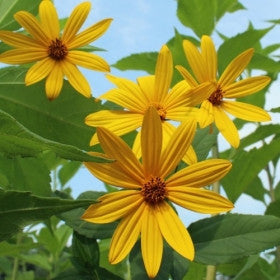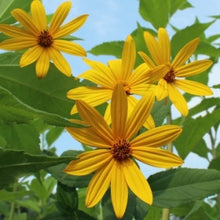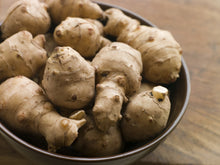Jerusalem Artichoke EARLY Dwarf Sunray Variety - Organic Sunchoke Sunroot Individual Tubers for planting or eating
Regular price
$4.99
Sale
This variety was selected many years ago by Thompson and Morgan Seed Company. Ripens early. Sometimes ready by August! This quasi dwarf sunchoke variety produces masses of tubers near the central stem. Easy to grow and certainly one of few that keeps a short profile. The tubers carry a few knobs but are easy to clean. This selection has a more pronounced flavor but is mild enough to use raw in salads. Does not spread as fast as others because of its compact habit. A great selection for containers too. The tubers are produced crowded around a central stem.
The Jerusalem artichoke (Helianthus tuberosus), also called sunroot, sunchoke, earth apple or topinambour, is a species of sunflower native to eastern North America, and found from eastern Canada and Maine west to North Dakota, and south to northern Florida and Texas. It is also cultivated widely across the temperate zone for its tuber, which is used as a root vegetable
The flowers are yellow and produced in capitate flowerheads, which are 5–10 centimetres (2.0–3.9 in) in diameter, with 10–20 ray florets. The tubers are elongated and uneven, typically 7.5–10 centimetres (3.0–3.9 in) long and 3–5 centimetres (1.2–2.0 in) thick, and vaguely resembling ginger root, with a crisp texture when raw. They vary in color from pale brown to white, red, or purple. The artichoke contains about 10% protein, no oil, and a surprising lack of starch
The tubers are sometimes used as a substitute for potatoes:they have a similar consistency, and in their raw form have a similar texture, but a sweeter, nuttier flavor; raw and sliced thinly, they are fit for a salad.
In Baden-Württemberg, Germany, over 90% of the Jerusalem artichoke crop is used to produce a spirit called "Topinambur", "Topi" or "Rossler". By the end of the 19th-century Jerusalem artichokes were being used in Baden to make a spirit called "Jerusalem artichoke brandy," "Jerusalem artichoke", "Topi", "Erdäpfler" "Rossler" or "Borbel."
Jerusalem artichoke brandy smells fruity and has a slight nutty-sweet flavour. It is characterised by an intense pleasing earthy note. The tubers are washed and dried in an oven before being fermented and distilled. It can be further refined to make "red rossler" by adding Common Tormentil, and other ingredients such as currants, to produce a somewhat bitter and astringent decoction. It is used as digestif as well as a remedy for diarrhea or abdominal pain.
Site. Plant sunchokes in full sun. The sunchoke prefers loose, well-drained soil but will grow almost anywhere. Add aged compost or sand to planting beds before planting; loose soil will make tuber harvesting easier. The sunchoke prefers a soil pH from 5.8 to 6.2. It is best to set sunchokes in a dedicated bed; once established they will spread rapidly and may require some effort to remove. The sunchoke can be planted densely to form a screen or windbreak.
Planting time. Sunchoke tubers can be planted in the garden as early as 2 to 3 weeks before the average last frost date in spring. They are best planted in soil that has warmed to 50°F. In warm-winter regions sunchokes can be planted in winter. Sunchokes require 110 to 150 days to reach harvest. Sunchokes grow best in temperatures ranging from 65° to 90°F.
Planting and spacing. Plant sunchoke tubers 2 to 6 inches deep, 12 to 18 inches apart. Space rows 36 to rows inches apart.
Water and feeding. Sunchokes grow best with an even, regular supply of water but can survive long periods of drought once established. Sunchokes require no extra feeding; they grow best in soil rich in organic matter.
Companion plants. Corn, rhubarb, peanuts. Avoid planting sunchokes with tomatoes.
Please enter the number of tubers desired before purchashing.
The Jerusalem artichoke (Helianthus tuberosus), also called sunroot, sunchoke, earth apple or topinambour, is a species of sunflower native to eastern North America, and found from eastern Canada and Maine west to North Dakota, and south to northern Florida and Texas. It is also cultivated widely across the temperate zone for its tuber, which is used as a root vegetable
The flowers are yellow and produced in capitate flowerheads, which are 5–10 centimetres (2.0–3.9 in) in diameter, with 10–20 ray florets. The tubers are elongated and uneven, typically 7.5–10 centimetres (3.0–3.9 in) long and 3–5 centimetres (1.2–2.0 in) thick, and vaguely resembling ginger root, with a crisp texture when raw. They vary in color from pale brown to white, red, or purple. The artichoke contains about 10% protein, no oil, and a surprising lack of starch
The tubers are sometimes used as a substitute for potatoes:they have a similar consistency, and in their raw form have a similar texture, but a sweeter, nuttier flavor; raw and sliced thinly, they are fit for a salad.
In Baden-Württemberg, Germany, over 90% of the Jerusalem artichoke crop is used to produce a spirit called "Topinambur", "Topi" or "Rossler". By the end of the 19th-century Jerusalem artichokes were being used in Baden to make a spirit called "Jerusalem artichoke brandy," "Jerusalem artichoke", "Topi", "Erdäpfler" "Rossler" or "Borbel."
Jerusalem artichoke brandy smells fruity and has a slight nutty-sweet flavour. It is characterised by an intense pleasing earthy note. The tubers are washed and dried in an oven before being fermented and distilled. It can be further refined to make "red rossler" by adding Common Tormentil, and other ingredients such as currants, to produce a somewhat bitter and astringent decoction. It is used as digestif as well as a remedy for diarrhea or abdominal pain.
Site. Plant sunchokes in full sun. The sunchoke prefers loose, well-drained soil but will grow almost anywhere. Add aged compost or sand to planting beds before planting; loose soil will make tuber harvesting easier. The sunchoke prefers a soil pH from 5.8 to 6.2. It is best to set sunchokes in a dedicated bed; once established they will spread rapidly and may require some effort to remove. The sunchoke can be planted densely to form a screen or windbreak.
Planting time. Sunchoke tubers can be planted in the garden as early as 2 to 3 weeks before the average last frost date in spring. They are best planted in soil that has warmed to 50°F. In warm-winter regions sunchokes can be planted in winter. Sunchokes require 110 to 150 days to reach harvest. Sunchokes grow best in temperatures ranging from 65° to 90°F.
Planting and spacing. Plant sunchoke tubers 2 to 6 inches deep, 12 to 18 inches apart. Space rows 36 to rows inches apart.
Water and feeding. Sunchokes grow best with an even, regular supply of water but can survive long periods of drought once established. Sunchokes require no extra feeding; they grow best in soil rich in organic matter.
Companion plants. Corn, rhubarb, peanuts. Avoid planting sunchokes with tomatoes.
Please enter the number of tubers desired before purchashing.



